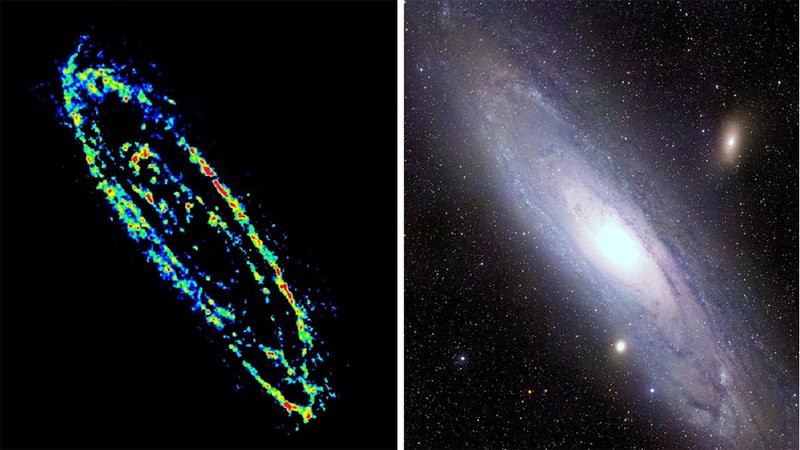At the high end we have the powerful, ionising wavelengths of X-rays and gamma rays, and at the low end we have the more zen-like non-ionising wavelengths such as microwaves and radio waves. All these different wavelengths interact with baryonic matter in different ways. This difference gives us an advantage in astronomy. For example, Earth's atmosphere will block gamma rays but will allow radio waves through.
This makes radio waves both ideal and infernal for ground-based astronomy.
If you tune your car radio in between the official broadcasting stations and listen to the static, some of static comes from the universe. (Radio static is how they discovered the Cosmic Microwave Background, or the radio wave echo of the Big Bang.) Sounds like this:
The atmosphere isn't uniformly transparent to radio waves, because our atmosphere is a rather complex thing. Some frequencies will shoot straight through, others will bounce around. This bouncing around can cause interference, which you can detect on your car radio as static.
The closer you are to population centres, the stronger the radio will be, because we have radio broadcasters and mobile phone cell towers and all sorts of radio-bright sources. Also, humidity in the atmosphere can block out radio waves.
So, what's an astronomer to do? The best earth-based radio astronomy sites are those away from civilisation, out where it's dry (low humidity) and "radio-quiet". Western Australia has a Radio Quiet Zone in the Murchison (our gratitude to the Wajarri Yamatji people, the traditional owners of this land) for the Square Kilometer Array, a large radio telescope. http://skatelescope.org/
Don't think that radio astronomy is out of reach for the amateur astronomers and citizen scientists. There are plenty of amateur radio astronomy clubs and organisations throughout the world.
But if you don't want to go hardcore and build your own radio telescope, you can still experience radio astronomy. If you tune your radio to the frequency of 1420 MHz (that's 1420 AM), you could listen to the hydrogen of the Universe speak to you. Sounds like this.
Spectral lines from other radio-sensitive stuff are detectable in radio astronomy:
- 1400 - 1427 MHz: 21cm hydrogen line
- 22.01 - 22.5 GHz: Water
- 23.6 - 24.0 GHz: Ammonia
- 36.43 - 36.5 GHz: Hydrogen cyanide and Hydroxil
- 72.77 - 72.91 GHz: Formaldehyde
More about how radio astronomy works.
Here's some pictures of stuff in radio frequencies.
Galaxy M51 (Whirlpool Galaxy) in radio and optical:
The planet Jupiter is also radio-bright:
Galaxy M87 showing off a radio-bright jet from its supermassive black hole:
The Sun in optical, radio and X-ray:
Galaxy M31 (Andromeda Galaxy) in radio and visible. Radio has a way of shining through the dust that would normally block visible light. This is one of the advantages of radio astronomy.
What the Milky Way looks like at 408 MHz:
Radio astronomy, indeed astronomy in all the wavelengths provides astronomers with a different point of view.
________________________
Her Grace once observed the universe through a mate's homemade radio telescope. It looked an awful lot like a silver umbrella attached to a laptop, because it was.


4 comments:
We studied this in our engineering, I hated this subject :P
A Peice Of My Life
That's pretty cool stuff! I am definitely going to play a bit with those radio frequencies and learn more.
Thanks for sharing :)
Best Wishes !
This makes me want to see everything in radio waves. I could listen to the echoes of the big bang all night. I think it would make for peaceful sleep.
----------
Eli@CoachDaddy
R is for Blogger Recognition
Very informative post! Enjoyed the insight and all the photos.
Perspectives at Life & Faith in Caneyhead
Post a Comment